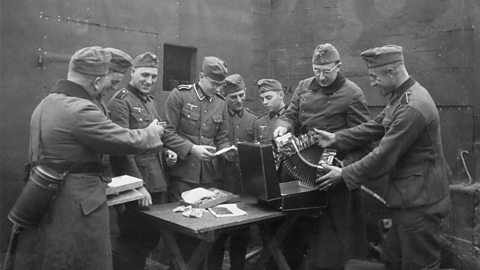On 8 May 1945, people in the UK celebrated Victory in Europe Day (VE Day) after learning of the final surrender of the Nazis.
Prime Minister Winston Churchill announced the news to the nation over the radio at 3pm and huge crowds quickly gathered in the streets to celebrate.
But what was life like for ordinary people in the UK once the war in Europe was over?
To discover how much changed in those first few weeks and months, we spoke to Dr Lucy Delap, a historian at the University of Cambridge.
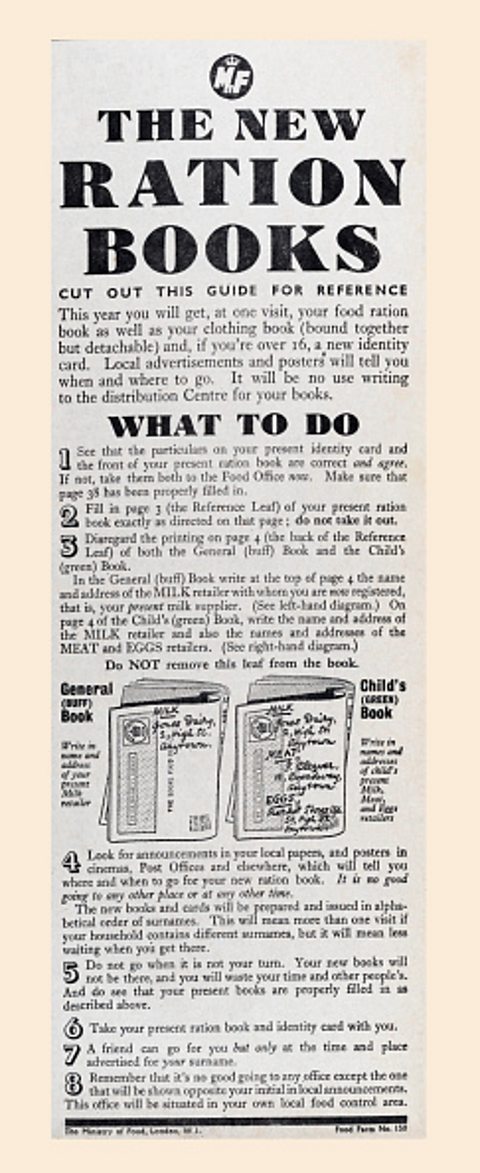 Image source, Universal History Archive
Image source, Universal History ArchiveRationing
Since January 1940, British people had been subject to food rationing. This meant that everyone was given a ration book containing coupons. These were exchanged for small amounts food that had to stretch for a week.
Spent all your coupons for the week? You simply couldnтt buy the food, or at least not legally. There was a thriving black market where some people were able to swap different foods.
As the war dragged on, rationing was also introduced on petrol (1939), clothes (1941) and soap (1942).
Disappointingly for many, VE Day didnтt mark the end of rationing due to economic difficulties following the war.
Dr Lucy Delap explains what happened:
тRationing and austerity remained intense in the late 1940s, and there was much resentment at having to queue for items. This was particularly harshly felt when bread and potato rationing began in 1946/7.
тFabric and clothing remained in very short supply, and the тnew lookт of full, long skirts developed by Dior in 1947 was impossible. The government developed тUtilityт versions of clothes and shoes, as well as furniture.
"Mending and reusing clothes remained essential, and regulations prevented unnecessary pockets and buttons on British clothes until 1949.т
 Image source, Universal History Archive
Image source, Universal History ArchiveHousing
During World War Two, more than 200,000 houses were completely destroyed by enemy bombing, while others were badly damaged.
This meant that by VE Day, the UK was facing a major housing shortage, particularly in urban areas. It caused a great deal of disruption to family life.
Dr Delap said: тMany young couples couldnтt expect their own place even after several years of marriage, and they were forced to live with parents. Some took matters into their own hands and squatted in former army accommodation or empty houses.т
To help ease the strain, the government stepped in. Dr Delap explains how:
тChurchill sponsored the construction of temporary тprefabт houses that proved very popular due to their gardens, fitted kitchens and inside toilets.т
Dr Delap continued, тThe houses were only intended to last around 5 to 10 years, but some are still inhabited today.т
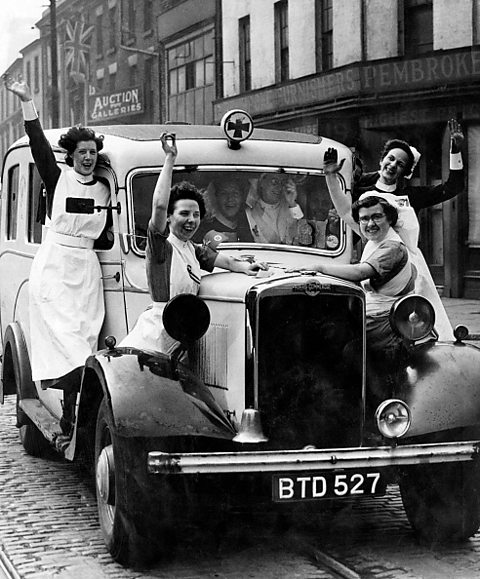
Working women
When World War One ended in 1918, women who had worked in wartime roles were quickly let go.
After VE Day in 1945, employers were much keener to hold onto their female workers. They were concerned that there would be a labour shortage.
Dr Delap explained: тWomen who were demobilised from the forces or nursing were given retraining, though often in domestic skills such as dressmaking, suggesting a widespread expectation that they would become homemakers.т
However, the Womenтs Land Army were excluded from this support during demobilisation. As a result, some land girls who had joined agricultural unions went on strike.
Dr Delap also highlights a generational divide in how women felt about working.
тMost women in their twenties wanted to stop working, but older women were often very keen to stay on т they had enjoyed the companionship at work, and many talked about how useful an extra income had been.т

 Image source, Bert Kneller
Image source, Bert KnellerFamily life
Following VE Day, separated families were slowly reunited. However, these reunions werenтt always smooth and happy, as Dr Delap explains.
тThere had been a lot of quick marriages under the intense pressures of war mobilisation. When partners were reunited, many did not find it easy, and there was a wave of divorces.
тNewspapers reports emphasised ideas of womenтs adultery, though in reality, both sexes had often strayed from marital fidelity.
тChildren also found it difficult to get used to having absent parents home, and many fathers felt awkwardly distant from children they had not seen grow up.т
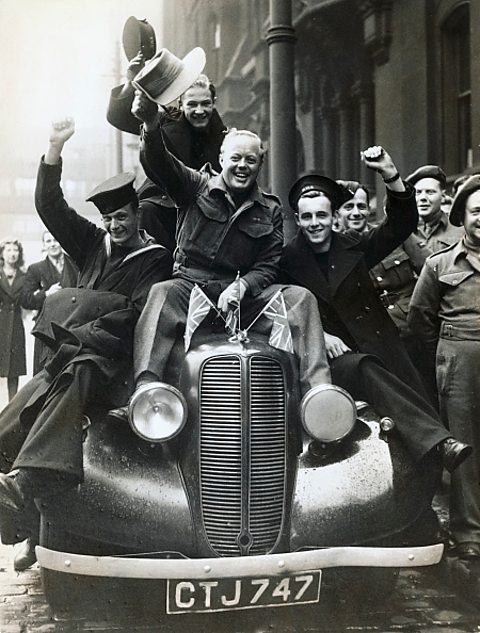 Image source, Manchester Daily Express
Image source, Manchester Daily ExpressWhat happened to British soldiers after VE Day?
Although fighting officially ended in Europe on VE Day, the war in the Far East and the Pacific continued until 15 August 1945.
During those three months, soldiers that had fought in Europe worried that they would be redeployed to fight elsewhere. Training was set up specifically for jungle warfare.
There was a running joke that the British Liberation Army (the name for the force in north-west Europe) would be renamed тBurma Looms Aheadт.
In the end, no soldiers were redeployed.
In fact, Alan Jeffreys, Senior Curator at the Imperial War Museum points out that it was predominantly Indian soldiers left fighting for Britain. Along with troops from other Commonwealth nations, they formed the 14th Army.
тIn the 14th Army, the breakdown is 340,000 Indian troops, 100,000 British and 80,000 African troops.т
The numbers of British soldiers fighting in South East Asia actually declined after VE Day because of Operation Python, a scheme under which long-serving soldiers could go home on leave.
тIn February 1945, those who had served three years and eight months were repatriated and that was extended in June to three years and four months. So a lot of the British army were actually returning home.т
For those soldiers still in Europe on VE Day, the journey home was not necessarily a fast one. In 1947, there were still one million active service personnel.
There was a quick return for some though, Jeffreys highlighted.
тThe quickest back to the UK were prisoners of war. Thirteen thousand prisoners of war were actually flown back in 200 Lancaster bombers, actually on VE Day.т
Returning to the UK didnтt necessarily mean a return to normality though.
тThose who had been away for long periods of time, say people who had been captured in the 1940 campaign, or those who had been out in South East Asia right from the beginning, they found it very difficult to readjust to life.т
 Image source, Manchester Daily Express
Image source, Manchester Daily ExpressGary Lineker takes an emotional journey to uncover his grandfather's untold World War Two story.
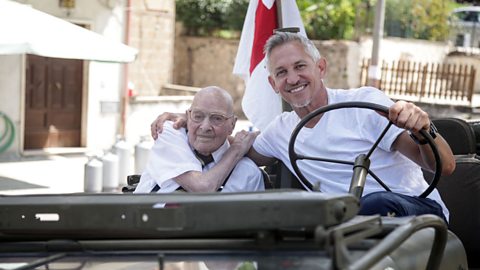
Listen to first-hand accounts of VE Day from the Imperial War Museums' archive.
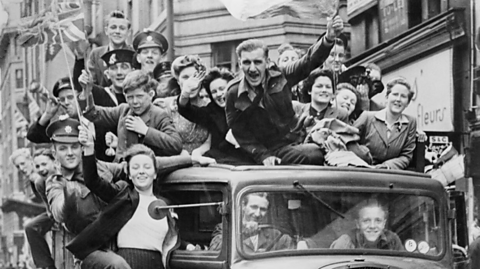
KS3 History: WW2
Learn more about WW2 with Bitesize.
